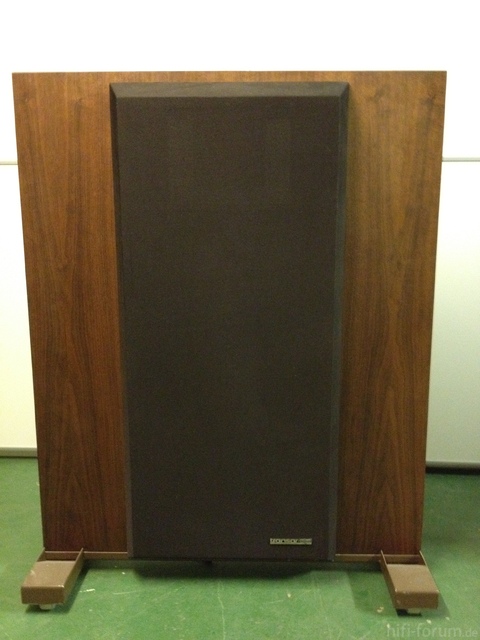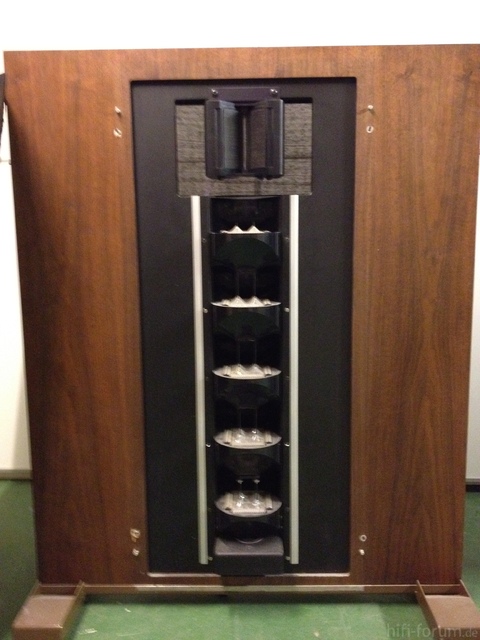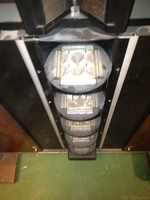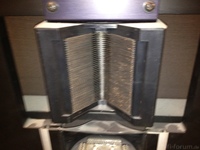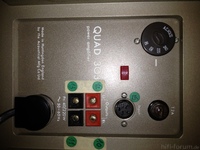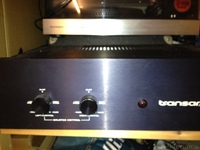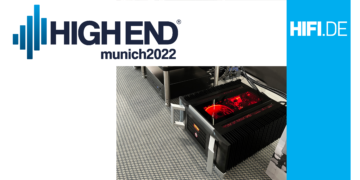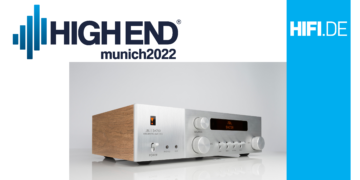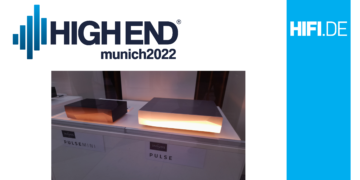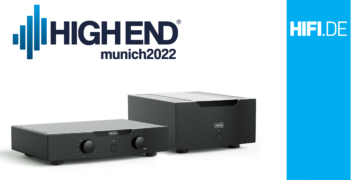| HIFI-FORUM » Stereo » Hifi-Klassiker » Alte Testberichte etc. zu ESS-Transar | |
|
|
||||
Alte Testberichte etc. zu ESS-Transar+A -A |
||
| Autor |
| |
|
Transar-Fan
Neuling |
#1
erstellt: 08. Dez 2004, 20:12

|
|
|
Kann mir jemand alte Testberichte (Kopien)über ESS-Transar zukommen lassen?
|
||
|
palucca
Hat sich gelöscht |
#2
erstellt: 08. Dez 2004, 21:33

|
|
|
hallo Transar-Fan, hast Du diese ESS Boxen? Ich habe zwar keine Testberichte, habe vor langer Zeit bei der Firma Intersonic gearbeitet, und die Firma hat die ESS Boxen damals in Deuteschland vertrieben. Wenn ich mich richtig erinnere, war in einer Schallwand ein Air-Motion Hochtöner und 4 oder 5 kleine Basschassis waagerecht in der Mitte. Diese Chassis waren duch Carbonfiberstäbe verbunden und endeten unten in der Schwingspule/Magnet. Dazur gehörte noch ein Subwoofer und eine elektronische Fequenzweiche. Frag doch mal bei ESS-USA nach. Vielleicht haben die noch mehr Infos. Der Entwickler Dr.Oscar Heil ist vor einigen Jahren verstorben. |
||
|
|
||
|
Passat
Inventar |
#3
erstellt: 09. Dez 2004, 01:20

|
|
|
Die ESS Transar II wurde in der Stereoplay 10/1981 getestet. Den Test habe ich allerdings nicht. Grüsse Roman |
||
|
Michael-Otto
Stammgast |
#4
erstellt: 09. Dez 2004, 14:25

|
|
|
Hallo Transar-Fan, Kein Problem, ein griff in mein High-End Archiv. Quelle: This article, which originally appeared in the September/October 1977 issue, is reprinted by permission of HI-FI/STEREO BUYERS' GUIDE. u.Transaudio Prospekt Hi-Fi/Stereo Buyer's Guide evaluates the Transar/atd full range Heil air-motion loudspeaker system by ESS Press Commentary Hail to the Heil ESS Transar/atd Speaker. A close-up look at what it is and how it works By William S. Gordon It stands more than three feet high. Rigid panels extend out from its central core-the wings of a futuristic gargoyle. In the center, the power core-a cylindrical acrylic tube filled with an array of wafer-like diaphragms. At the apex of the drive cylinder, the electromagnetic motor, coupled through a complex array of incredibly stiff carbon fiber rods to the drivers. And suspended over all, the silver-black corrugated folds of the super-high- frequeney emitter. A hush falls over the room. The engineer deftly mans the control console. Power on. The silence is broken, and with a mighty roar, all in its presence are carried back in time by the winged machine. The time warp is instantaneous. There is no sensation of motion. The days, the years, do not slip by in reverse order as the flipping leaves of a calendar. You are there. In Severance Hall. George Szell is on the podium. The space around you is filled with sound. The incredible time machine has spoken. And speak it does, for it is the newest concept in loudspeakers-the ESS Heil Transar/A.T.D. The all-Heil system is, perhaps, the longest awaited debut in high fidelity history-certainly the most anticipated loudspeaker in history. It's finally here, or, to be more precise, two prototype stereo systems were hand-fabricated and demonstrated to the cognescenti this past spring. As of this writing, ESS is tooling up for production and Plans to have the first production run of 50 sets out by early fall. They will be sold on a limited basis by selected ESS dealers throughout the country. ESS plans to follow the early units right through to the home of the ultimate user. They'll get quick feedback on whatever potential shipping or manufacturing problems exist on this radically new speaker. One of the earliest prototypes was earmarked for the Winter GES in Chicago. It was so mishandled by the airlines that it arrived in pieces and had to be re-assembled in the back room. Accordingly, it missed most of the show. ESS has vowed that that won't happen to their production units. But it is generally conceded hv the engineering fraternity-at least in a tongue-in-check manner -that any device that can survive being shipped into and out of Chicago will pass any military or NASA reliability spec in existence. So perhaps ESS has experienced the worst, first. The new Heil low frequency driver is the result of three years' continuous research by both ESS and Dr. Heil. While it is not an air-motion transformer in the sense of the Heil high frequency driver, it is an equally unique innovatiou by this exceptionally talented scientist. In essence, the problem he sought to solve with the low frequency driver was the same one he tried to circumvent with the Heil tweeter-the inability of the conventional cone to follow the audio signals in a faithful manner vis-a-vis phase and transient response. With proper engineering, the voice coil of a conventional dynamic driver can be made to move in accordance with the electrical signal, accurately and rapidly-at least suffiicently fast to be used as a woofer. The problem with the woofer is the cone. It must be large in order to move a sufficient volume of air to generate appropriately large sound pressure levels at low frequencies. And it must be rigid enough to move as a whole and not collapse under the strain. Conventional paper cones that meet these conditions are massive and so of relatively low efficiency. But, to the ESS/Heil way of thinking, they have an even more serious problem. It takes time for the sonic energy to move up the cone, from the apex, connected to the voice coil, to the final outer edge. Thus, although the coil and base of the cone may move in synchrorism with the signal, the outer edge responds late. The speaker is out-of-phase with itself, different sections reacting at different times. ESS improved matters with the Bextrene woofer in the amt lb. Bextrene is a British innovation-a rubber,/polystyrene compound with exceptional physical properties: low mass and high rigidity. Although Bextrene can be vacuum-formed, doing so to make a loudspeaker cone is no mean feat. A "normal" vacuum-forming operation would produce a cone with a thick outer rim and a thin apex, precisely the opposite of what is desired. Suffice it to say that ESS overcame the technological problems and has been able to form cones up to 12 inches in diameter. Although the low mass, high rigidity and relatively high propagation velocity of Bextrene offered significant theoretical advantages over a paper cone, the basic "cone problem" still remained. And that's what the Heil low frequency driver is all about. Dr. Heil reasoned that the real solution would come about by using a multiplicity of sma11 radiators that could be driven simultaneously and in phase. Each radiator would be so small that it would move and radiate as a whole, essentially instantaneously in the low frequency region. The resonant points of these miniature radiators could be moved to a frequency sufficiently above the band of operation so that the resonance would not be excited. Imagine, if you will, a hollow plexiglas cylinder, perhaps three feet high and five inches in diameter. Now, imagine five horizontal plates across the inner diameter of the cylinder and located at equal distances along its height. Each of these plates supports a pair of thin Lexan sheets, vacuum-formed to produce four bubbles, one in each quadrant of the sheet. (ESS and Dr. Heil may shudder at the analogy, but the formed Lexan sheets look very much like a section of "bubble-wrap"-that all-pervasive packing material.) Four carbon-fiber rods extend almost the entire length of the cylinder, linking the corresponding bubbles on each of the five sheets. The four rods are then affixed to a voice coil at the top of the cylinder. The voice coil and its magnet structure are similar to that of a conventional woofer. As the voice coil moves, the vibrations are carried down through the rods to each of the five Lexan sheets. Each of them move, pumping the air in the cylinder. In effect, the speaker "cone" has been divided into five small cones-or rather 20 very small bubble-cones. Since the bubbles are so small, they can move as a whole, in-phase, and their resonant point is above the low frequency range of the speaker. Carbon-fiber has one of the highest sound propagation velocities of any material known to man. It is extremely rigid for its mass. In fact, ESS claims that it takes less than 1/300,000 of a second (about 33 microseconds) for the energy to be transmitted from the voice coil to the farthest radiator. Thus, all five sheets move together, in-phase. To allow the vibrating air (the sound) out of the cylinder, sections are cut from its periphery. Internal baffles are arranged at a 45° angle near each sheet. These baffles direct the sound from the upper surface of the sheet out of the front of the Minder, while that from the lower surface is reflected to emerge in the rear. This prevents the out-of-phase radiation from the lower surface (emerging to the rear) from canceling that from the upper surface (emerging to the front.) Thus, the cylinder acts as a dipole radiator, much like a large electrostatic panel. Of course, at low frequencies, the out-of-phase rear radiation would just flow around the outside of the cylinder and still cancel the useful sound. Therefore, baffle panels are attached like wings to opposite sides of the cylinder to lengthen the sound path. The total width of the system is about four feet. The Heil low frequency driver operates up to 1 kHz where the signal is crossed over to a bi-polar Heil high frequency driver that sits above the cylinder. The high frequency driver is similar to that used in the ESS amt lb and uses the original Heil pleated-diaphragm air-motion transformer design. That unique driver has been described many times in the past and so we needn't go over it again here. Suffice it to say that it is widely acclaimed for its exceptional frequency and transient response, wide horizontal dispersion and high power handling capability. The Heil low frequency driver provides its best performance when fed from a current-source amplifier. A current-source amplifier provides an output current proportional to input level rather than an output voltage proportional to input. Essentially it has a very low damping factor-much less than 1-as opposed to the typical high-damping-factor transistor amp. ESS will be marketing the Heil Transar/A.T.D. with its own low frequency current-source power amp. The special amplifier actually inserts the Heil low frequency driver within the feedback loop to insure linearity between the output current and the input voltage. The amplifier also includes the requisite crossover networks at 1 kHz-active type with 18 dB/octave slopes. Your present amplifier would still be used to drive the high frequency air-motion transformer. You'd probably be best off with an amp that has separate preamp and power amp sections. The preamp would feed the crossover network in the special amp, and the highs would be routed back through your power amp. Although the special amp is quite powerful-on the order of 250 watts/channel, the system efficiency is very high-about 93 dB SPL at 1 meter from 1 watt. With its dipole radiation pattern, you can expect to find that the sound character-especially on the low end-will be affected by the placement of the Transar in your listening room. When we heard them, they were spaced about 3 feet out from the wall. This gave an excellent illusion of depth to the imagery. They're not cheap. The expected price range is about $1,000 per speaker plus $800 for the amp-approximately $2,800 for the package. But, that's not firm at the time we're writing this. Only two sets of prototype existed, and they took a month each to build. Obviously, firm pricing has to await production experience. Again, Dr. Heil has come up with a radically new concept in loudspeaker design and the long-awaited all-Heil system is now a reality. It was worth waiting for. The sound is prodigious. Frequenzgang: Subwoofer 26 - 95 Hz Transar-Bass 95 - 800 Hz Heil-Air-Motion-Transformer 800 Hz – 23 KHz Daten Subwoofer Frequenzgang: +0 -3 dB, 26 Hz - 95 Hz akustische Ausgangsleisung: bei 26 Hz 330 mW, 50 Hz 4,5 W Tieftöner-Ausführung: 305 mm Magnetgewicht 2,4 kg Schwingspule 5,08 cm Schwingspulenwicklung 3-fach Resonanzfrequenz 14 Hz Gesamtvolumen 300 Liter Daten Transar Schallwand Frequenzgang: 95 -23 KHz Heil-Tieftöner: 95 Hz - 800 Hz Heil-Air-Motion-Transformer:00 - 23 KHz . Daten Heil-Air-Motion-Transformer Gesamtabstrahlfläche:139 cm2 Rechteckanstiegszeit: 15 Mikrosekunden Übertragungsverhältnis: 5,3 : 1 Magnetgewicht: 5,9 kg magnetischer Fluss: 4.000 Gauss Daten Heil-Tieftöner Effektive Abstrahlfläche:413 cm2 Diaphragma-Material: Lexan Magnetgewicht: 5,8 kg magnetischer Fluss: 12.500 Gauss Schwingspulenwicklung: 2-fach Rechteckanstiegzeit: 40 Mikrosekunden Elektronische Frequenzweiche Regeleinheit für Subwoofer, getrennte Regler für Transar Schallwand Ausführung Schallwand und Subwoofer: Nußbaum furniert Stoffbespannung: braun/schwarz Maße:Schallwand: Breite 70,1 cm Tiefe 38,1 cm Höhe 114,3 cm Subwoofer: Breite 60,0 cm Tiefe 60,0 cm Höhe 40,0 cm Gewicht: 100 kg Versandgewicht: 136 kg Gruß Michael-Otto |
||
|
charles_b
Stammgast |
#5
erstellt: 20. Mai 2007, 10:43

|
|
|
auch wenn der letzte Beitrag schon sehr alt ist: Danke für dies Infos. NAch der Beschreibung ist es genau dieses System, welches ein Händler hier in München in der Auslage stehen hat - um sie "später mal zum laufen zu bringen." Was ist so ein Paar heute wert? Gruß charles_b |
||
|
Mohrle9999
Ist häufiger hier |
#6
erstellt: 25. Mai 2007, 22:57

|
|
|
in Italien werden die Lautsprecher für 16000 € angeboten. Gib mal in google "Ess Transar" ein. Ein Schweizer hat die Transar für 13000 SFr angeboten. Ich habe 2004 Transar LS mit ziemlich kaputten Folien für 600 € gekauft. Habe monatelang die Folien geklebt. Jetzt laufen sie wieder. Allerdings fehlt mir der "Konstantstromverstärker", der damals zu den LS dazugehörte. Vor 1 bis 2 Jahren habe ich das Nachfolgemodell Transar ATD2 für ca 600 € gekauft. Auch bei diesen LS waren die Folien defekt, jedoch nicht so schlimm wie bei der Ur-Transar mit 5 übereinanderliegenden Mittelton bzw. Bassmodulen. Zum Glück konnte ich für ca. 300 € fast neuwertige Mitteltöner kaufen, sodaß die Transar ATD2 jetzt komplett ist. Wieviel sie wert sind, ist schwer zu sagen, da es praktisch keinen Markt gibt und auch nur alle Schaltjahre solche LS in ebay zum Kauf angeboten werden. Die meisten Transar spielen wegen der sehr anfälligen Folien nicht mehr. Die Transar ist nur etwas für Liebhaber oder Sammler. Vor 30 Jahren muß sie ein Superlautsprecher gewesen sein. Es wäre mal interessant, sie mit heutigen LS in der Preisklasse zwischen 5000 € und 15000 € zu vergleichen. Die Räumlichkeit und Auflösung der LS ist senationell. Was verlangt denn der Händler in München? Ist es die Transar oder die Transar ATD2? Hat er eine Ahnung von solchen LS? Gruß mohrle9999 ESS Eclipse M 102, ESS Transar, ESS Transar ATD 2 [Beitrag von Mohrle9999 am 25. Mai 2007, 22:59 bearbeitet] |
||
|
charles_b
Stammgast |
#7
erstellt: 26. Mai 2007, 10:51

|
|
|
Hi und danke für die Antwort! Der Händler in München ist einer, der den ganzen Laden mit halb angefangenen Projekten "zugemüllt" hat. Es sieht aus wie bei Peters Bastelstunde. Also alles "Projekte" die mal was werden sollen.... Die Transar stehen in der Auslage, auch da "will er mal was machen". Ich war allerdings schon lange nicht mehr in dem Laden. Nach einem Preis habe ich also nicht gefragt. Ich habe auch keine Ahnung über den Zustand der Dinger. - vielleicht ein Anlass, mal wieder dort vorbeizuschauen und nebenbei zu fragen.... charles_b |
||
|
danyw
Neuling |
#8
erstellt: 30. Mai 2007, 08:49

|
|
|
Hallo Zusammen, hallo Mohrle, sehr interessiert verfolge ich Eure Diskusseion. In den 70ern hat mein Vater eine Transar ATD gekauft. Die Lautsprecher hat er immer noch, nur leider defekt. Wie kann ich sehen ob es eine ATD 1 oder ATD 2 ist?. Ich glaube es ist aber eine ATD1 (Bilder von der ATD2 im Internet schauen anders aus). Leider ist bei einem der Lautsprecher genau dies Carbonstrebe gebrochen. Ist das noch zu reparieren? Wer kann so etweas machen? Danke für die Hilfe Daniel |
||
|
Mohrle9999
Ist häufiger hier |
#9
erstellt: 30. Mai 2007, 15:33

|
|
|
hallo danyw die Transar ATD1 erkennt man daran, daß sie 5 übereinaderliegende Membranen hat, während die Transar ATD2 nur 4 übereinanderliegende Membranen hat und zusatzlich einen großen Subwoofer. Auch die Holzteile, d.h. die Schallwand ist verschieden. Es gibt auch verschiedene technische Änderungen am Magneten und der Schwingspule. Die ATD1 hat einen speziellen Verstärker, der seinerzeit zu den Lautsprechern gehörte, ein sogenannter Konstantstromverstärker. Zur ATD2 gehört eine Frequenzweiche in einm Kästchen von der größe einer Zigarrenkiste, mit der man die Lautstärke der verschiedenen Frequenzbereiche regeln kann. Die Karbonfiberstäbe kann man meines erachtens relativ problemlos mit 2 Komponenten Epoxidharzkleber kleben. Ich habe allerdings noch nicht gehört, daß diese Stäbe kaputt gehen. Eher reißen die Folien an den Aufhängungen aus. Gruß mohrle9999 |
||
|
danyw
Neuling |
#10
erstellt: 31. Mai 2007, 16:33

|
|
|
Hallo Mohre9999, danke für die Antwort. So wie Du es besschreibst ist es eine ATD1. Da ist ein extra Vertstärker dabei. wenn ich beim nächsten mal daheim bin, schaue ich dann genau nach. Auch ob "nur" der Carbon Stab gebrochen ist, oder ob auch die Aufhängungen an den Folien gerissen sind. Definitiv weiss ich, dass einer der Carbonstäbe zwischen dem obersten und dem darunter liegenden Membranen gebrochen ist...Die Lautsprecher stehen seitdem, und das ist bestimmt schon weit über 20 Jahre her. Vielleicht wegen "Kaumbenutzung" auch die Folien noch i.O. Den Carbonstab einfach zu kleben halte ich für sehr schwierig. Die Berührungsfläche ist ja nur sehr klein und muss wahrscheinlich doch einiges an Zug verkraften...hast Du so was schon mal gemacht und hat es dann gehalten. Ich stelle mir ein "Drumherumlaminieren" vor... Nächstes mal wenn ich heimkomme werde ich den einen Lautsprecher mal ausprobieren. Mal sehen, ob überhaupt ein Ton rauskommt. Wo schließt man den mitgelieferten Konstantstromvertärker an? So weit ich weiss hatte die Anlage zwei Endverstärker (MCIntosh und mitgelieferter Konstantstromverstärker). Eine Endstufe war an dem Hochtöner angeschlossen, die andere an den Magneten für die übereinanderliegenden Membrane. Gibt es eigentlich ein Adresse, wo man solche Exoten reparieren lassen kann. Ich hab zwar keine linken Hände aber ich möchte auch nichts kaputt machen....bin im Raum München, meine Eltern wohnen am Chiemsee. Viele Grüße Daniel |
||
|
charles_b
Stammgast |
#11
erstellt: 31. Mai 2007, 22:21

|
|
|
Hallo Daniel, da du aus dem Raum München kommst, könnte es für dich hilfreich sein, auch mal bei diesem Händler vorbeizuschauen, der die Dinger in der Auslage stehen hat oder hatte. Der Typ macht einen sehr gut informierten Eindruck. Nähe Donnersberger Brücke, soll ich die Straße mal raussuchen? Gruß charles_b |
||
|
danyw
Neuling |
#12
erstellt: 01. Jun 2007, 09:00

|
|
|
Hallo charles_b, der Händler an der Donnersberger Brücke würde mich interessieren - ist ein Katzensprung von mir weg... Danke für die Mühe und viele Grüße Daniel |
||
|
charles_b
Stammgast |
#13
erstellt: 01. Jun 2007, 15:03

|
|
...also, das müßte es sein: Joker-Hifi, Bermannstr. 3 Tel. 089 507 377 ...mußte selber jetzt auch erst suchen! Viel Erfolg, berichte was du von dem Laden hältst! charles_b |
||
|
Mohrle9999
Ist häufiger hier |
#14
erstellt: 04. Jun 2007, 11:49

|
|
|
hallo Daniel, es ist richtig, daß man 2 Verstärker benötigt. Den mitgelieferten Konstantstromverstärker für den Tieftonbereich, d.h. für die übereinanderliegenden Membranen und einen konventionellen Endverstärker für den Hochtöner (air motion transformer). Um die Lautstärkepegel von Hoch- und Tieftöner angleichen zu können, ist einen spezielle Regelschaltung vorhanden. Was das Kleben der Stäbe anbelangt, würde ich vorschlagen, die Stelle mit 2 Halbschalen zusätzlich zu schienen. Falls die LS nicht zu reparieren sind, hätte ich evtl. Interesse and den Sachen als Ersatzteile und hätte auch Interesse an dem Konstantstromverstärker. Mir fehlt dieser nämlich. Ich habe lediglich die Schallwände. Gruß Robert |
||
|
danyw
Neuling |
#15
erstellt: 09. Jun 2007, 23:41

|
|
|
Hallo Zusammen, danke für die Antworten ... ich war am Wochenende wieder mal bei meinen Eltern daheim und hab mir die Transarr angeschaut. Ich hatte mich getäucht, die Stäbe sind nicht gebrochen. Es ist nur ein "Querstab" ab, der anscheinend zwischen dem Untersten und dem darüber liegenden Membran als Anschlag dient. Den kann man glaube ich wieder ankleben. Ansonsten schaut alles O.K. aus. An den genauen Defekt konnte sich mein Vater nach der langen Zeit nicht meh erinnern. Einfach einschalten habe ich mich nicht getraut, ich wollte erst Eure Meinung hören. Wie soll ich da vorgehen, ich möchte nicht noch Weiteres beschädigen. Die gesamte Anlage steht ja schon eine Ewigkeit und ist arg verstaub. Ich überlege eine funktionierende Anlage an die Boxen anzuschliessen...für die Hochtüner sollte das kein Problem sein. Kann man das auch mit den Tieftönern machen oder ist der KOnstantstromverstärker Pflicht. Robert, wie betreibst Du Deine Lautsprecher ohne diesen Spezialverstärker? Über Tipps bin ich sehr dankbar. Charles_B - bie joker-hifi war ich aus Zeitgründen noch nicht. Ich werde aber nach einem Besuch berichten.... Viele Grüße Daniel |
||
|
Mohrle9999
Ist häufiger hier |
#16
erstellt: 11. Jun 2007, 12:56

|
|
|
hallo Daniel, die Querstrebe kann wohl problemlos geklebt werden. An ihr ist eine Feder befestigt, mit der die Bässe zentriert werden. Ich würde einfach mal einen Verstärker an die Lautsprecher anschließen. Zur Not getrennt beide Systeme betreiben, um zu sehen, ob sie funktionieren. Normalerweise geht der AMT nicht kaputt. Den Tieftonbereich würde ich auch getrennt zu Testzwecken betreiben. Wenn was kommt, dann funktioniert der Lautsprecher. Bewege die Membranen doch mal nach oben und unten, um zu testen, ob sie sich aus der Ruhelage bewegen lassen. Du kannst dabei testen, ob die Schwingspule fest ist bzw. durchgebrannt ist. Die Membranen lassen sich bei mir problemlos nach oben und unten bewegen. Die vorhin angesprochene Feder bringt sie wieder in die Ausgangslage. Wenn sich die Membranan nicht bewegen lassen, sind sie in der Schwingspule festgefressen. In diesem Fall dürfte die Schwingspule durchgebrannt sein. Wenn es nur kratzt, dann kann die Schwingspule auch durchgebrannt sein oder die Schwingspule reibt sich nur am Magneten. In diesem Fall muß sie neu zentriert werden. Vielleicht ist auch die Sicherung durchgebrannt. Dort, wo das Lautsprecherkabel an der Buchse angeschlossen wird, befindet sich ein Überlastungsschutz. Auch der kann defekt sein. Der Konstantstromverstärker kann letztendlich defekt sein. In einem Testbericht, den ich dir schicken kann, ist davon die Rede, daß der Konstantstromverstärker kaputt gegangen ist. Das System war insgesamt sehr anfällig und hat sich wohl deshalb auch nicht durchgesetzt. Ich betreibe meine Lautsprecher mit einem normalen Verstärker über die Frequenzweiche der ATD2.Ich habe glücklicherweise zwei Stück davon. Das ist besser als nichts. Es fehlt dabei das ganz große Baßerlebnis, weil dies gerade die Aufgabe des Konstantstromverstärkers ist, der mir fehlt. Das Nachfolgemodell ATD2 hat deshalb einen Subwoofer spendiert bekommen. Gruß Robert |
||
|
Transar_ATD
Neuling |
#17
erstellt: 02. Jan 2012, 15:40

|
|
|
Hallo zusammen, ich bin neu hier - habe ein Set dieser lautsprecher inklusive Verstärker und Tweeter - voll funktionstüchtig inklusive Unterlagen. Einzig einer der Speaker hat kleine Risse in der Plastik Membran die mal geklebt wurden - und zwar schlecht! Habe leider keinen Platz daher sind die Dinger eingelagert und das ist schade. Was kann ich damit machen? Wo und wie finde ich Leute die sich damit auskennen. Ich bin über jeden Feedback bzw. Kontakt hierzu dankbar! Besten Gruß und Dank! |
||
|
Transar_ATD
Neuling |
#18
erstellt: 09. Feb 2012, 20:00

|
|
|
shabbel
Inventar |
#19
erstellt: 09. Feb 2012, 20:29

|
|
|
Wo ist denn Dein Standort? Und gibt es ein Foto, auf dem der Riss zu sehen ist? |
||
|
Transar_ATD
Neuling |
#20
erstellt: 09. Feb 2012, 20:44

|
|
|
Die Lautsprecher sind in Mainz gelagert. Die Risse (es sind leider meherer aber nur bei einem der Lautsprecher) kann ich fotografieren und einstellen. Dauert aber noch ne Woche da ich das selber machen muss und nicht vor Ort bin. Kennen Sie sich damit aus? |
||
|
shabbel
Inventar |
#21
erstellt: 10. Feb 2012, 08:57

|
|
|
Wenn Du Fotos von den Rissen hast, kann Dir bestimmt jemand weiterhelfen. Warten wir mal ab. |
||
|
onkel_böckes
Inventar |
#22
erstellt: 11. Feb 2012, 03:15

|
|
|
Herr Gollan in Münsterv kann dir helfen, der macht so was! Grüße! |
||
| ||
|
|
||||
| Das könnte Dich auch interessieren: |
|
Alte ESS Concept CE-2. Lohnt Restauration? bullirider am 30.12.2007 – Letzte Antwort am 01.01.2008 – 4 Beiträge |
|
ESS Heil amt 5 Fabsen2102 am 16.02.2005 – Letzte Antwort am 25.02.2005 – 13 Beiträge |
|
ESS AMT 1 tidus_riot am 10.07.2004 – Letzte Antwort am 27.07.2013 – 56 Beiträge |
|
Testberichte z.b. von .2004,etc. WesL5001 am 22.09.2012 – Letzte Antwort am 22.09.2012 – 3 Beiträge |
|
ESS AMT Monitor rma am 02.06.2006 – Letzte Antwort am 23.06.2006 – 21 Beiträge |
|
Alte Testberichte von Hifi Receivern ????? Wo ??? bodi_061 am 01.02.2006 – Letzte Antwort am 03.02.2006 – 19 Beiträge |
|
ESS Lautsprecher gefunden Orbyo am 12.02.2013 – Letzte Antwort am 21.02.2013 – 19 Beiträge |
|
ESS AMT 1 D steffele am 19.01.2015 – Letzte Antwort am 11.12.2020 – 16 Beiträge |
|
ESS AMT Monitor bacherle am 12.11.2005 – Letzte Antwort am 16.11.2005 – 9 Beiträge |
|
ESS AMT Monitor bacherle am 23.03.2006 – Letzte Antwort am 23.03.2006 – 4 Beiträge |
Foren Archiv
Anzeige
Produkte in diesem Thread

Aktuelle Aktion
Top 10 Threads in Hifi-Klassiker der letzten 7 Tage

- Wie erkenne ich defekte Feinsicherungen
- Ghettoblaster - welcher hat den besten Klang?
- JBL LX-155
- Best of Arcus - oder: wo bleibt der Arcus-Liebhaber-Thread?
- Onkyo SC-1500 vs. Yamaha NS-2000
- Übersicht aller älteren Philips CD Player
- Kaufberatung: Hi-Fi Verstärker der 70 bzw. 80 Jahre
- Weltempfänger - bloß welcher?
- Lautsprecher Cabasse Goelette M2
- Sony WM-6DC wirklich gut?
Top 10 Threads in Hifi-Klassiker der letzten 50 Tage

- Wie erkenne ich defekte Feinsicherungen
- Ghettoblaster - welcher hat den besten Klang?
- JBL LX-155
- Best of Arcus - oder: wo bleibt der Arcus-Liebhaber-Thread?
- Onkyo SC-1500 vs. Yamaha NS-2000
- Übersicht aller älteren Philips CD Player
- Kaufberatung: Hi-Fi Verstärker der 70 bzw. 80 Jahre
- Weltempfänger - bloß welcher?
- Lautsprecher Cabasse Goelette M2
- Sony WM-6DC wirklich gut?
Top 10 Suchanfragen

Forumsstatistik

- Registrierte Mitglieder929.101 ( Heute: 3 )
- Neuestes MitgliedAndreas84bj
- Gesamtzahl an Themen1.559.688
- Gesamtzahl an Beiträgen21.732.470
